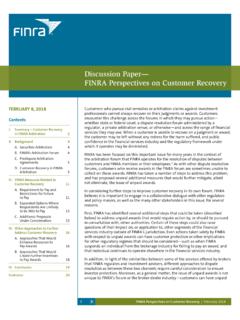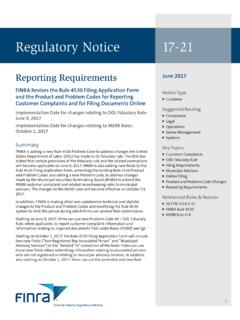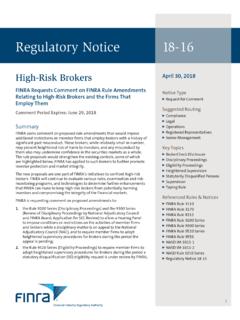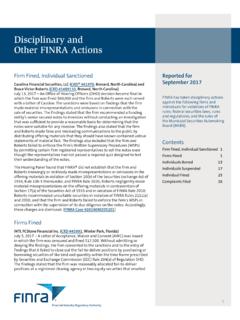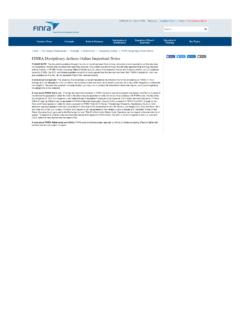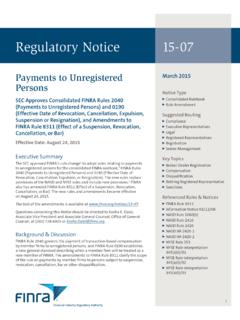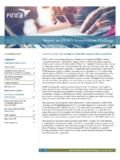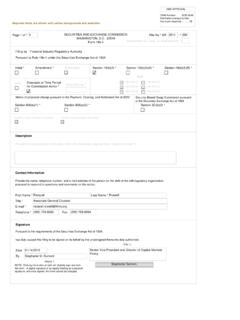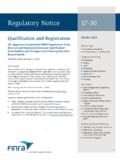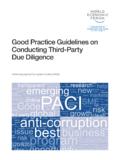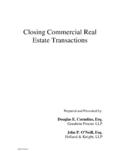Transcription of Regulatory Notice 17-40 - finra.org
1 Summary finra is issuing this Notice to provide guidance regarding member firms obligations under finra Rule 3310 (Anti-Money Laundering Compliance Program) in light of the Financial Crimes Enforcement Network s (FinCEN) adoption of a final rule on Customer Due Diligence Requirements for Financial Institutions (CDD Rule).FinCEN s CDD Rule became effective July 11, 2016. Member firms must be in compliance with its provisions by May 11, 2018. Questions concerning this Notice should be directed to: 00 Michael Rufino, Executive Vice President, Head of Member Regulation Sales Practice, at (212) 858-4487 or by email at Crane, Associate General Counsel, Office of General Counsel, at (202) 728-8104 or by email at or00 Meredith Cordisco, Associate General Counsel, Office of General Counsel, at (202)
2 728-8018 or by email at Notice 17-40 November 21, 2017 Notice Type 00 GuidanceSuggested Routing 00 Compliance 00 Legal 00 Operations00 Senior ManagementKey Topics 00 Anti-Money Laundering00 Compliance ProgramsReferenced Rules & Notices0031 CFR , Bank Secrecy Act00 finra Rule 3310 FinCEN s Customer Due Diligence Requirements for Financial Institutions and finra Rule 3310 finra Provides Guidance to Firms Regarding Anti-Money Laundering Program Requirements Under finra Rule 3310 Following Adoption of FinCEN s Final Rule to Enhance Customer Due Diligence Requirements for Financial Institutions Background & DiscussionThe Bank Secrecy Act1 (BSA), among other things, requires financial institutions,2 including broker-dealers, to develop and implement anti-money laundering (AML) programs that, at a minimum, meet the statutorily enumerated four pillars.
3 3 These four pillars require broker-dealers to have written AML programs that include, at a minimum: 00the establishment and implementation of policies, procedures and internal controls reasonably designed to achieve compliance with the applicable provisions of the BSA and implementing regulations;00independent testing for compliance by broker-dealer personnel or a qualified outside party; 00designation of an individual or individuals responsible for implementing and monitoring the operations and internal controls of the AML program; and 00ongoing training for appropriate addition to meeting the BSA s requirements with respect to AML programs, broker-dealers must also comply with finra Rule 3310, which incorporates the BSA s four pillars, including requiring broker-dealers AML programs to establish and implement policies and procedures that can be reasonably expected to detect and cause the reporting of suspicious transactions.
4 On May 11, 2016, FinCEN, the bureau of the Department of the Treasury responsible for administering the BSA and its implementing regulations, issued the CDD Rule5 to clarify and strengthen customer due diligence for covered financial institutions,6 including broker-dealers. In its CDD Rule, FinCEN identifies four components of customer due diligence: (1) customer identification and verification; (2) beneficial ownership identification and verification; (3) understanding the nature and purpose of customer relationships; and (4) ongoing monitoring for reporting suspicious transactions and, on a risk basis, maintaining and updating customer As the first component is already an AML program requirement, the CDD Rule focuses on the other three components.
5 Specifically, the CDD Rule focuses particularly on the second component by adding a new requirement that covered financial institutions identify and verify the identity of the beneficial owners of all legal entity customers at the time a new account is opened, subject to certain exclusions and exemptions. The CDD Rule also addresses the third and fourth components, which FinCEN states are already implicitly required for covered financial institutions to comply with their suspicious activity reporting requirements, by amending the existing AML program rules for covered financial institutions to explicitly require these components to be included in AML programs as a new fifth pillar. As a result of the CDD Rule, member firms should ensure that their AML programs are updated, as necessary, to comply with the CDD Rule by May 11, 2018.
6 2 Regulatory NoticeNovember 21, 201717-40 This Notice provides guidance to member firms regarding their obligations under finra Rule 3310 in light of the adoption of FinCEN s CDD Rule. In addition, the Notice summarizes the CDD Rule s impact on member firms, including the addition of the new fifth pillar required for member firms AML programs. Member firms should also consult the CDD Rule as well as FinCEN s related FAQs,8 which FinCEN indicates it will periodically Rule 3310 and Amendments to Minimum Requirements for Member Firms AML Programs Section 352 of the USA PATRIOT Act of 20019 amended the BSA to require broker-dealers to develop and implement AML programs that include the four pillars mentioned above. Consistent with Section 352 of the PATRIOT Act, and incorporating the four pillars, finra Rule 3310 requires each member firm to develop and implement a written AML program reasonably designed to achieve and monitor the member firm s compliance with the BSA and implementing regulations.
7 Among other requirements, finra Rule 3310 requires that each member firm, at a minimum: (1) establish and implement policies and procedures that can be reasonably expected to detect and cause the reporting of suspicious transactions; (2) establish and implement policies, procedures, and internal controls reasonably designed to achieve compliance with the BSA and implementing regulations; (3) provide for annual (on a calendar-year basis) independent testing for compliance to be conducted by member firm personnel or a qualified outside party;10 (4) designate and identify to finra an individual or individuals ( , AML compliance person(s)) who will be responsible for implementing and monitoring the day-to-day operations and internal controls of the AML program and provide prompt notification to finra of any changes to the designation; and (5) provide ongoing training for appropriate persons.
8 FinCEN s CDD Rule does not change the requirements of finra Rule 3310, and member firms must continue to comply with its However, FinCEN s CDD Rule amends the minimum statutory requirements for member firms AML programs by requiring such programs to include risk-based procedures for conducting ongoing customer due This ongoing customer due diligence element, or fifth pillar required for AML programs, includes: (1) understanding the nature and purpose of customer relationships for the purpose of developing a customer risk profile; and (2) conducting ongoing monitoring to identify and report suspicious transactions and, on a risk basis, to maintain and update customer As stated in the CDD Rule, these provisions are not new and merely codify existing expectations for firms to adequately identify and report suspicious transactions as required under the BSA and encapsulate practices generally undertaken already by securities firms to know and understand their However, to the extent that these elements, which are briefly summarized below, are not already included in member firms AML programs, the CDD Rule requires member firms to update their AML programs to explicitly incorporate them.
9 finra is considering whether further rulemaking is necessary to more closely align finra Rule 3310 with FinCEN s CDD Rule in light of the now-codified fifth pillar requirement for firms AML programs. Regulatory Notice 317-40 November 21, 2017 Summary of Fifth Pillar s RequirementsUnderstanding the Nature and Purpose of Customer RelationshipsFinCEN states in the CDD Rule that firms must necessarily have an understanding of the nature and purpose of the customer relationship in order to determine whether a transaction is potentially suspicious and, in turn, to fulfill their suspicious activity reporting To that end, the CDD Rule requires that firms understand the nature and purpose of the customer relationship in order to develop a customer risk profile.
10 The customer risk profile refers to information gathered about a customer to form the baseline against which customer activity is assessed for suspicious transaction Information relevant to understanding the nature and purpose of the customer relationship may be self-evident and, depending on the facts and circumstances, may include such information as the type of customer, account or service offered, and the customer s income, net worth, domicile, or principal occupation or business, as well as, in the case of existing customers, the customer s history of The CDD Rule also does not prescribe a particular form of the customer risk Instead, the CDD Rule states that depending on the firm and the nature of its business, a customer risk profile may consist of individualized risk scoring, placement of customers into risk categories or another means of assessing customer risk that allows firms to understand the risk posed by the customer and to demonstrate that The CDD Rule also addresses the interplay of understanding the nature and purpose of customer relationships with the ongoing monitoring obligation discussed below.
